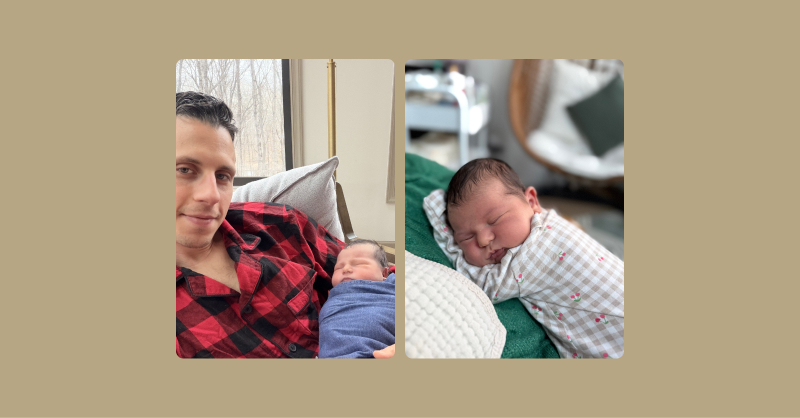BL&T No. 177: Overcoming Fear & Comfort from Parenthood to Professional Life

This post originally appeared in my weekly newsletter, BL&T (Borrowed, Learned, & Thought). Subscribe
Borrowed
"Each time you practice a stretch without excess discomfort, you are helping to “convince” the nervous system that the stretch is safe. In fact, “stretch tolerance” is probably the mechanism by which most stretching programs serve to increase flexibility."
From "Playing With Movement: How to Explore the Many Dimensions of Physical Health and Performance" by Todd Hargrove [Book]
Learned
We officially packed away our son Mylo's bassinet this weekend—a milestone that seemed to come in the blink of an eye.
The truth is that Mylo might still be sleeping by our bedside if left to my own devices. However, thanks to my wife Dana's suggestion, he's now comfortably sleeping in his crib, in his room.
Mylo is almost six months old now. Dana's foresight in transitioning him to his crib early on likely saved us from a situation where he became reliant on our presence for good sleep. Instead, as of last week, he's been making it through the night! He does wake occasionally but mostly soothes himself back to sleep.
Fingers crossed this sticks!
The funny thing is the transition was probably more nerve-wracking for me than Mylo. During those first few nights, I secretly set an alarm to check on him. Dana didn't know, of course. What was I worried about? I couldn't even really tell you, so I kept it to myself.

In his short time on Earth, Mylo has already taught me a valuable lesson about fear and comfort. Fear of an unwanted outcome and leaning into the comfort of what I know. This combination can mislead me into thinking I'm making the right choice when in reality, I might be holding him back. It's about me, not him.
This principle extends to all relationships – with ourselves, friends, spouses, teams, etc. We often think we're doing good, but really, we’re afraid or worried about the outcome— inadvertently holding us and others back.
Years ago, while managing the design team at Barrel, we had a junior designer who struggled. In retrospect, we realized they might have benefited from more guidance and structure around work assignments.
At that time, I was reevaluating the team's structure, including roles and growth paths. Rather than more or less throwing a junior designer into the work, we mapped assignment types to the different roles on the team. Our goal was to improve onboarding and set new hires up for success. Sensible in theory.
Soon after, we backfilled the role with a stellar candidate—a recent graduate who was highly motivated and eager to learn.
We started off excited to integrate them into the team. We assigned them to work alongside more experienced designers and gradually gave them ownership of smaller projects.
Initially, it felt like the right approach, akin to learning to ride a bike. They soaked up everything—our processes, UX thinking, and design methodology. But we kept the training wheels on too long.
A few months after their one-year "Barrelversary," they moved on to a new opportunity.
In hindsight, our approach was more about our fears, of giving them too much responsibility too soon and the potential risks to projects, than about the designer’s growth. This led to their disengagement and our loss of a promising talent.
We've come a long way since this experience, but the temptation to follow the same path still pulls us from time to time, especially in matters of poor performance or situations gone wrong. We avoid tough decisions, convincing ourselves we're making the right choice.
It can be present in our personal lives, too.
Maybe we put off pursuing our passion, like writing or painting, telling ourselves that family needs or job demands come first. We let fear and perceived obligations overshadow our personal growth and joy.
Similarly, we might have a friend stuck in a job that makes them miserable, but fear of the unknown keeps them from moving on. We offer comfort, avoiding the honest advice that might encourage them to embrace change.
Taking the difficult path is never easy, but acknowledging it can be a good start. In doing so, we can view our decisions from different angles and contemplate the factors influencing our perspective.
In the book Outlive, author Peter Attia writes about how "removed all discomfort of any kind from modern life, we have lost touch with the fundamental skills (not to mention the frequent suffering) that once defined what it meant to be human." Attia is referring to physical discomfort, but I see a strong correlation with mindset and decision-making.
I've found value in regularly stepping out of my comfort zone, whether it be through new activities like archery, altering my routine, or enduring a challenging workout. While seemingly unrelated, these experiences train my mindset to embrace discomfort, especially when I know it's the right path.
Seeing Mylo grow and become more independent, even in these small ways, is pretty incredible. The first nights we let him cry instead of rushing to comfort him were challenging. Yet, he soon learned to self-soothe and drift back to sleep. Holding back from intervening, we realized his decreasing need for our immediate comfort. I remember feeling a unique sense of relief and pride, a subtle yet powerful sign of his growing independence. I can only imagine how these small moments will mirror larger and larger milestones in the years to come.
All that said, I look forward to continuing to find ways to practice this mentality and notice where I'm letting fear or comfort drive me, especially when it comes to Mylo.
Thought
Have I ever been in a situation where my fear or discomfort influenced my decisions, and do I wish I had chosen differently in hindsight?








